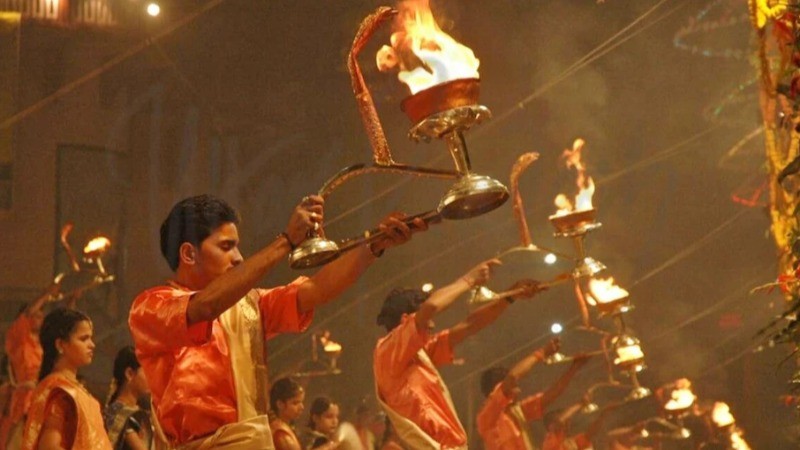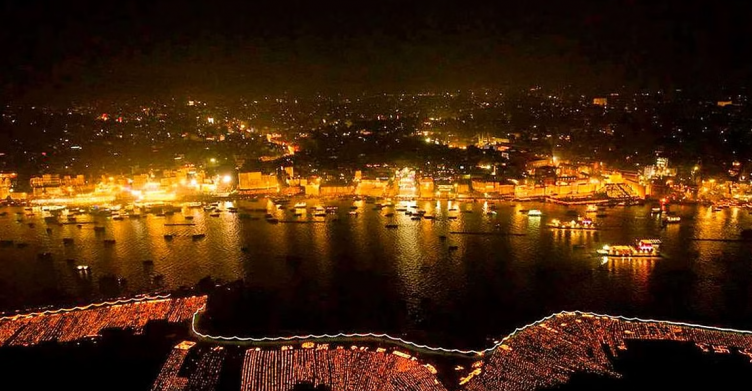
A captivating and mesmerizing spectacle that breathes upon the onset of dawn and at dusk with the setting sun on the banks of the Ganges on Varanasi Ghats: The Ganga Aarti. The rhythmic chants symbolizing pure devotion and gratitude, with synchronized movements of performers, visuals of countless lamps showcasing the blend of air, water and fire, altogether creating an unforgettable experience of a lifetime.
The Ganga Aarti is deeply rooted to India’s rich culture and heritage, not only the city of Benaras alone. Located in one of the holiest cities of India, Benaras’s Ganga Aarti is an otherworldly experience. Now, the ritual of honoring Ganga is recognized and officially declared by UNESCO as the ‘Intangible Cultural Heritage of Humanity’. It celebrates the historical, cultural and religious significance of the age-old tradition of Ganga Aarti that continues to draw a massive footfall from round the world.
The Ganga Aarti builds communal ties, establishes religious devotion, and further escalates cultural tourism, at the same time providing economic sustainability to nearby locales. It is more than a spiritual practice, profoundly impacting people’s social and spiritual lives, fostering connections and strengthening communities.
The history
The Ganga Aarti at Kashi is mentioned in the holy scripture, Skanda Purana. As per legends, it is said that Lord Brahma had performed a Yagna (fire sacrifice) at the Dashashwamedh ghat to bring back Lord Shiva from exile. Ever since then, Ganga Aarti began to be organized on the ghats of Benaras. It is however not known that in what format was the Aarti held back in ancient times. The present one dates to 1991, and continues to be the same.
About

In Benaras, the Ganga Aarti is primarily performed at the Dashashwamedh Ghat near the Kashi Vishwanath temple, where the devotees can have the most divine experience. The ghat is linked to Lord Brahma in the ancient scriptures. It is easily accessible to reach from major parts of the city, and offers a direct view of the flowing river. The other ghats to watch out for are Assi Ghat and Rajendra Prasad ghat.
It’s when everything is in hassle, crowded and noisy, but when there is the Shankhnaad (blowing of the conch), everything falls silent. After this, the Aarti is carried on with the lighting of lamps, incense sticks, flower offerings and the sound of bells and chants, the huge brass lamps moved in a synchronized manner making it a sight to behold. The aarti is performed from a specific area of a long platform, with 7 short platforms shed under an umbrella like structure above them. Seven young learned Brahmins of Kashi perform all the offerings and aarti, they symbolize the seven saptarishis who performed the Puja for Maa Ganga. The chants and shlokas not only worship Maa Ganga, but also include praise of Lord Shiva and Lord Vishnu.
For the longest time, Ganga Aarti was only performed in the evenings at the Dashashwamedh ghat, during winters by 6:00 pm and in summers by 7:00 pm exactly at the sunset and continues for straight 45 minutes. But sooner, the tradition of morning aarti was adopted. In the mornings, the Ganga Aarti is performed at the Assi Ghat starting by dawn AT 5:00 am, continuing till 7:00 am. It is known as Subah-e-benaras, an ideal way to begin with your morning in the city. Before the Ganga Aarti, vedic verses are also recited, offering prayers to the basic elements of the universe: earth, water, sky and fire. After the aarti, the Benaras gharanas, who are the classical musicians start with the music and ragas, who have been performing the art since 200 years.
Apart from the ghats, people also witness the Ganga Aarti from the rooftop of the lodges, houses, hotels and restaurants. But you can opt for watching the aarti from the boats sailing in the holy waters of the Ganga. It is docked near the ghat, offering you the perfect view of the Aarti.
The Ganga Aarti has always witnessed a huge gathering of visitors on its ghats every day. The only exception was during the period of COVID-19, the aarti continued but with the presence of only one priest. The gathering of masses was halted then.
It is recommended that when you visit the Ghat, make sure you are an hour before at the place. Also, try attending the Ganga Aarti both during the morning as well as in the evening. Subah-e-benaras is also a very unique spiritual experience.
It is believed that participating in the Ganga Aarti purifies the soul and attracts positive energy, engulfing the surroundings with peace and spirituality. Now, when it is being observed as the Intangible cultural heritage, the world has understood the significance of the rich cultural legacy. Thus, the Ganga Aarti shall not be missed by any chance, where you will know that it is more than simply a religious ritual!